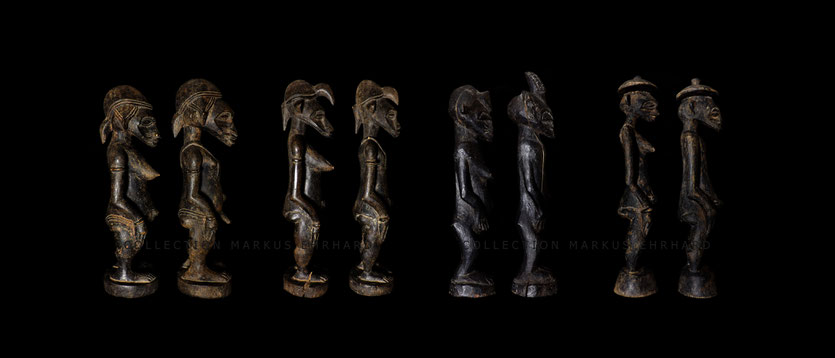
"Ha! - there is not a second, better carver than Sabariko", said Zangvagnan Koné about his uncle Sabariko Koné in an interview with Karl-Heinz Krieg. Sabariko Koné (+1949) lived and worked in Ouézomon. Nearby Nafoun and Korhogo, Ouézomon was/is one of the carver's centres of the Senufo in Ivory Coast, where Koné also founded a school for carvers. Beside his two sons, Yéralo and Meinyerigué Koné, Tchètin Bêh Konaté was one of his students. Songuifolo Silué from Sirasso knew Sabariko as well. Songuifolo just observed him carving his sculptures, but he did not adapt Sabariko's style. Songuifolo had a very strong own artistic awareness.
Comparing Tugubele couples of the same genre it becomes obvious, how important the impact of Sabariko's style was for this region and a time from 1920 till today. Everyone still knows the name Sabariko Koné.
The couple left was carved by Sabariko Koné after 1930, his style matured to a solid and compact silhouette, with traditional features like hair, scars and jewelry. His proportion shows very short sturdy legs with huge feet (toes are carved in every detail), massive elongated upper bodies with capital heads. The upper arms are extended matching the body proportion, the ellbow is below the waist line, the underarm is anatomically impossibly shaped in a curve. The long hands are placed in the front of the upper thights. These statues have no logic anatomy.
In the comparisson above you can see all these features applied by other carvers (Tchètin Bêh Konaté from Zaguinasso, Ponzié Coulibaly from Pitangomo, Yalourga Soro from Ganaoni) from that region. They did not copy Sabariko, they adapt these style elements in their own handwriting. Traceable the work of Sabariko Koné did set standard in Senufo sculpture.

Starting left:
Tugubele couple, carved by Sabariko Koné, Koulé from Ouézomon. Woman: 24,0 x 6,5 x 6,0 cm, Wood. Man: 25,5 x 9,5 x 7,5 cm, wood. Collected by Dramani Kolo-Zié Coulibaly 2016 in Boundiali, belonged to the Tugubele convult of a diviner in Ndara.
Literature:
- Wenn Urform Form bestimmt, Markus Ehrhard, pages 20 - 23, 122 - 125.
- Kunst und Religion bei den Gbato-Senufo, Elfenbeinküste, Karl-Heinz Krieg und Wulf Lohse, pages 29 - 30.
- Afrika Begegnung, aus der Sammlung Artur und Heidrun Elmer, pages 28 - 29.
- Aus Afrika, Ahnen - Geister - Götter, Jürgen Zwernemann, Wulf Lohse, pages 68 - 69.
- Kunst & Kontext, Ausgabe 4 2012, Dr. Andreas Schlothauer, pages 4 - 10.
Tugubele couple, carved by Tchètin Bêh Konate, Koulé from Zanguinasso. *1920 +1996.
Collected by Dramani Kolo-Zié Coulibaly 2016 in Boundiali.
Woman: 25,0 x 6,0 x 6,0 cm, wood.
Man: 26,0 x 6,0 x 5,5 cm, wood.
Literature:
- Wenn Urform Form bestimmt, Markus Ehrhard, pages 126 - 133.
- Afrika Begegnung, aus der Sammlung Artur und Heidrun Elmer, page 43.
- Kunst & Kontext, Ausgabe 4 2012, Dr. Andreas Schlothauer, pages 5 - 7.
Tugubele couple, carved by Melié Coulibaly , Fono from Pitangomo.
Man: 21,0 x 4,0 x 4,0 cm, wood.
Woman: 19,5 x 4,0 x 4,0 cm, wood.
Literature:
- Wenn Brauch Gebrauch beeinflusst, Markus Ehrhard, pages 80 - 81.
- Wenn Urform Form bestimmt, Markus Ehrhard, pages 38 - 39.
Tugubele couple, carved by Yalourga Soro, Koulé from Ganaoni.
Man: 20,5 x 4,5 x 4,0 cm, wood.
Woman: 20,5 x 4,5 x 4,0 cm, wood.
Literature:
-Wenn Urform Form bestimmt, Markus Ehrhard, pages 22 - 23, 136 - 137.
Copyright content and images by Markus Ehrhard


Kommentar schreiben